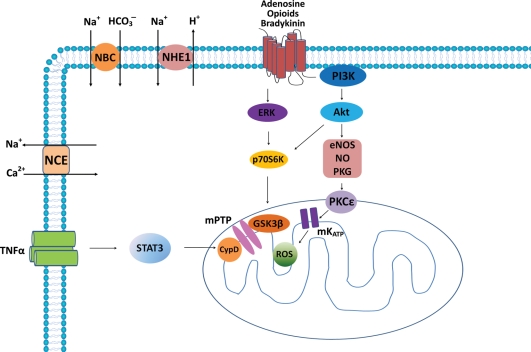Figure 2.
Major signalling pathways identified in ischaemic postconditioning (PostC). Several autacoid substances (adenosine, bradykinin, opioids, TNFα) are produced endogenously and act as triggers in PostC. These autacoids bind to G-protein-coupled receptors (GPCR) and stimulate RISK pathway which recruits PI3K/Akt and ERK, activates PKCɛ through eNOS/NO/PKG, and phosphorylates (inhibits) GSK3β, thereby delaying opening of mPTP. PKCɛ may stimulate ROS generation through activating mKATP channels, and consequentially inhibit mPTP opening. The RISK pathway also induces some other anti-apoptosis and anti-necrosis pathways. An alternative SAFE pathway recruits TNFα, which binds to TNF receptor resulting in STAT3 activation. STAT3 targets CYP-D leading to mPTP inhibition. PostC also inhibits the Na+/H+ exchanger in a PKG-dependent fashion and reduces Ca2+ accumulation, because the sarcolemmal Na+/H+ exchanger and the Na+ bicarbonate co-transporter are activated at the onset of reperfusion, which causes intracellular Ca2+ accumulation through reverse activation of the Na+/Ca2+ exchanger and induces cell apoptosis and necrosis. CYP-D, cyclophilin-D; eNOS, endothelial nitric oxide synthase; ERK, p42/p44 extracellular-regulated kinase; GPCR, G-protein-coupled receptor; GSK3β, glycogen synthase kinase-3β; mPTP, mitochondrial permeability transition pore; mKATP, mitochondrial KATP channel; NBC, Na+ bicarbonate co-transporter; NCE, Na+/Ca2+ exchanger; NHE1, Na+/H+ exchanger; NO, nitric oxide; PKCɛ, protein kinase C subtype ɛ; PKG, cGMP-dependent protein kinase; ROS, reactive oxygen species; STAT3, signal transducer and activator of transcription-3; TNFR, TNF receptor.

